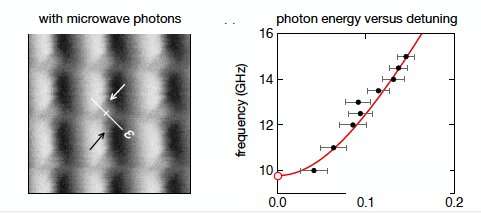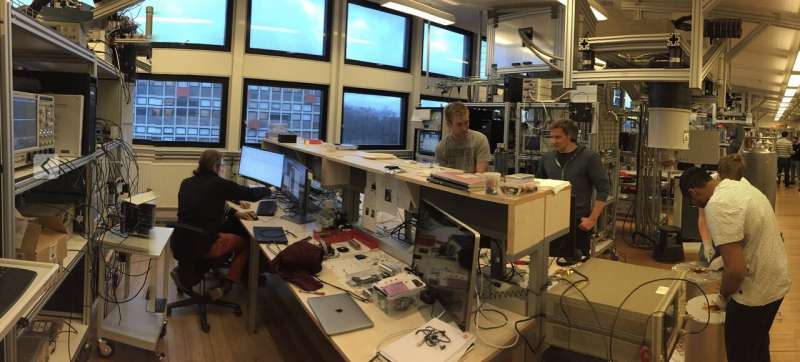May 12, 2020 feature
The observation of photon-assisted tunneling signatures in Majorana wires

Researchers at the University of Copenhagen and Microsoft Quantum Lab Copenhagen have recently carried out a study investigating the potential of Majorana zero modes, zero-energy quasiparticle states that can be found in superconductive hybrid nanowires, as a means of protecting quantum data. Their paper, published in Nature Physics, outlines the observation of photon-assisted tunnelling signatures in a Majorana nanowire, offering interesting new insight that could pave the way towards better understanding these quasiparticle states.
"Our long-term goal is to develop a means of protecting and controlling quantum information for quantum computing applications," co-author of the paper Prof. Charles Marcus told Phys.org via e-mail. "An intriguing proposal is to use Majorana zero modes to offer protection at the physics level, rather than at the circuit level using redundancy and error correction."
At a physical level, Majorana zero modes conceal specific information, more precisely whether an excess electron is nonlocally present or absent inside a given topological superconductor. This information cannot be unveiled using tools for the collection of local measurements.
Theoretically, using Majorana zero modes to protect quantum data should thus be rather simple and straight-forward. However, this has so far proved very difficult to realize, as it requires substantial efforts, including the development of methods to read out zero-energy states and the design of hybrid materials that can reach these states in the first place.
"A number of concrete early steps towards realizing this concept were laid out in a theoretical paper we wrote in 2016, but getting even the subcomponents of our proposed system to work is challenging," Marcus said. "A critical component is a topological superconducting junction where Majorana modes can be coupled and decoupled using electrical pulses. Our recent experiment was designed to test that one particular component: the site where the coupling of Majorana modes across a junction could be controlled."

Photon-assisted tunnelling is a technique that can be used to 'connect' quantum states of unequal total energy, using a photon with an energy matching the difference. The total energy of the quantum states in this experiment depend on the presence of an excess electron at discrete zero-energy states.
This effect ultimately allowed the researchers to detect a difference in average charge occupation. As the photon's frequency is energy that can be controlled, they could infer the energy difference between the quantum states and ultimately convert this into a coupling strength.
"In the early days of superconducting and spin qubit devices, photon-assisted tunnelling was often used as a technique to map the energy difference between qubits states," David van Zanten, another researcher involved in the study, told Phys.org. "The minimum energy difference is defined by the energy of the coherent exchange coupling. Based on this earlier work, we set off to use photon-assisted tunnelling as a tool to identify and characterize the coherent coupling between Majorana fermions of different pairs."
The method used by the researchers is quite simple. It entails measuring the average charge occupation of a double-island structure that hosts Majorana zero modes, while simultaneously applying a microwave tone to a nearly metallic structure coupled predominantly to one of the structure's islands.
For their technique to work, the researchers had to develop suitable topological superconducting double-island structures and RF SET charge sensors that could be introduced inside an InAs/AI nanowire, which was in turn to be placed on a substrate to which microwaves could be applied. In addition, they had to carefully tune all device knobs and identify an extended range at which all conditions necessary for the photon-assisted tunnelling of Majorana zero modes were fulfilled.

The authors worked closely with a team of researchers specialized in quantum materials, led by Peter Krogstrup. This group of scientists was responsible for growing the wires used in the experiment.
Ultimately, the materials and methods used in their experiment allowed the researchers to observe photon-assisted tunnelling signatures at a finite magnetic field, inducing 1e gate periodicity in both islands. Nonetheless, one should be cautious when interpreting their findings, as theirs is merely a preliminary result.
"The most noteworthy aspect of our study lies in the internal consistency between the different measurements and observations presented in the paper, along with other work by others in our same research community," van Zanten said. "Each of our measurements independently indicates the presence of discrete states at zero energy in both islands, a picture consistent with Majorana zero modes. The internal consistency hints that our interpretation is valid, but does it prove Majorana coupling? No."
According to the researchers, other fermionic states that occur at zero energy could also be constructed in a way that resembles Majorana zero modes. For this reason, their results, along with similar ones gathered by other teams in the past, should be considered as interpretations rather than facts.
"Which existing interpretation is most reasonable is subject to debate, which is fuelled by the variety of results collected by different groups," Marcus said. "What we have shown is that at high field, there's a discrete state in the wires at zero energy (precisely where a Majorana would reside) and that by tuning a junction we can couple and uncouple these zero-energy modes, measuring their strength of coupling."

The recent study carried out by the Copenhagen-based team provides new observations that can be added to the pool of findings related to zero modes in Majorana wires collected by different research teams over the past decade or so. In the future, their work could serve as a basis for new studies investigating the potential of these states for enhancing the security of quantum technology.
"In our next studies, we would like to use material systems that are easier to work with," Marcus said. "The nanowires we used were a great start but placing individual wires by hand is no way to build a network of Majoranas. Materials are the key to progress in this field: new materials, cleaner materials, easier-to-work-with materials."
In addition to repeating their experiment using different materials, the researchers plan to conduct studies incorporating multi-junction systems. In fact, past research evidence suggests that systems with multiple junctions enable the creation of devices that are more sophisticated and interesting.
"We would now also like to introduce other eyes in the development of our system, which would allow us to rapidly and confidently distinguish between zero modes that can hide quantum information and those that cannot," Marcus and van Zanten said. "The braiding of Majorana zero modes is a key demonstration that our zero energy states possess the key property that is needed for information protection, but that measurement has not been done. Our present experiment introduces the basic theory, but now material scientists and experimentalists will have to test it."
More information: David M. T. van Zanten et al. Photon-assisted tunnelling of zero modes in a Majorana wire, Nature Physics (2020). DOI: 10.1038/s41567-020-0858-0
David Aasen et al. Milestones Toward Majorana-Based Quantum Computing, Physical Review X (2016). DOI: 10.1103/PhysRevX.6.031016
Journal information: Nature Physics , Physical Review X
© 2020 Science X Network





















